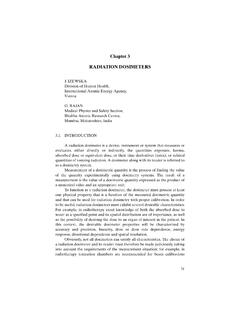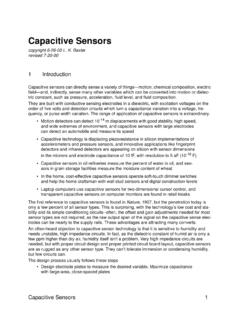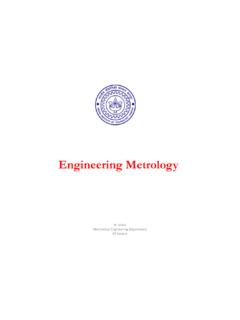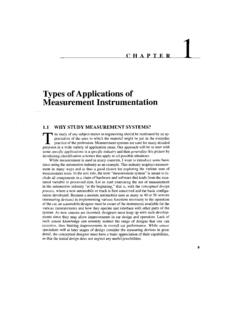Transcription of Fundamentals of Surveying - 筑波大学
1 Fundamentals of Surveying Theory and Samples Exercises Prof. Dr. Yuji Murayama Division of Spatial Information Science Surantha Dassanayake Graduate School Life and Environment Sciences University of Tsukuba Definition of Surveying Surveying has to do with the determination of the relative spatial location of points on or near the surface of the earth. It is the art of measuring horizontal and vertical distances between objects, of measuring angles between lines, of determining the direction of lines, and of establishing points by predetermined angular and linear measurements.
2 Along with the actual survey measurements are the mathematical calculations. Distances, angles, directions, locations, elevations, areas, and volumes are thus determined from the data of the survey. Survey data is portrayed graphically by the construction of maps, profiles, cross sections, and diagrams. The importance of the Surveying Land Surveying is basically an art and science of mapping and measuring land. The entire scope of profession is wide; it actually boils down to calculate where the land boundaries are situated.
3 This is very important as without this service, there would not have been railroads, skyscrapers could not have been erected and neither any individual could have put fences around their yards for not intruding others land. 2. Types of Surveying Geodetic Surveying : The type of Surveying that takes into account the true shape of the earth. These surveys are of high precision and extend over large areas. Plane Surveying : The type of Surveying in which the mean surface of the earth is considered as a plane, or in which its spheroidal shape is neglected, with regard to horizontal distances and directions.
4 3. Different methods of Surveying Control Survey: Made to establish the horizontal and vertical positions of arbitrary points. Boundary Survey: Made to determine the length and direction of land lines and to establish the position of these lines on the ground. Topographic Survey: Made to gather data to produce a topographic map showing the configuration of the terrain and the location of natural and man-made objects. Hydrographic Survey: The survey of bodies of water made for the purpose of navigation, water supply, or sub-aqueous construction.
5 Mining Survey: Made to control, locate and map underground and surface works related to mining operations. Construction Survey: Made to lay out, locate and monitor public and private engineering works. Route Survey: Refers to those control, topographic, and construction surveys necessary for the location and construction of highways, railroads, canals, transmission lines, and pipelines. Photogrammetric Survey: Made to utilize the principles of aerial photogrammetry, in which measurements made on photographs are used to determine the positions of photographed objects.
6 Astronomical survey: generally involve imaging or "mapping" of regions of the sky using telescopes. 4. Basic Trigonometry functions for Distance and angular Measurements Pythagorean Theorem In a right triangle, the square of the hypotenuse is equal to the sum of the squares of the other two sides. C 2 = A2 + B2. where: C is the hypotenuse (side opposite the right angle). A and B are the remaining sides. Units of angular Measurement The most common angular units being employed in the United States is the Sexagesimal System.
7 This system uses angular notation in increments of 60 by dividing the circle into 360 degrees;. degrees into 60 minutes; and minutes into 60. seconds. Therefore;. 1 circle = 360 = 21,600 = 1,296,000 . 1 = 60 = 3600 . 1 = 60 . 5. Most useable functions of Trigonometry All trigonometric functions are simply ratios of one side of a right triangle to a second side of the same triangle, or one side over another side. The distinction between functions is which two sides are compared in the ratio. The figure below illustrates the side opposite from and the side adjacent to Angle A, and the hypotenuse (the side opposite the right angle).
8 The trigonometric functions of any angle are by definition: Sine A = Opposite Side / Hypotenuse cosine A= Adjacent Side / Hypotenuse Tangent A = Opposite Side / Adjacent Side and inverting each ratio, we have cosecant = Hypotenuse / Opposite Side = 1/sine A. secant = Hypotenuse / Adjacent Side = 1/cosine A. cotangent = Adjacent Side / Opposite Side = 1/tangent A. 6. Algebraic Signs of the Trigonometric Functions in each Quadrant Using the definitions on the previous page, we can determine the values of the functions for each angle shown below.
9 List the Sine, Cosine, and Tangent of each angle in both fractional and decimal form. Quadrat 1. Tan = 3/4 = Quadrat 2. Sin 180- = 3/5 = Cos 180- = -4/5 = Tan 180- = 3/-4 = Quadrat 3. Sin 180+ = -3/5 = Cos 180+ = -4/5 = Tan 180+ = -3/-4 = Quadrat 4. Sin 360- = -3/5 = Cos 360- = 4/5 = Tan 360- = -3/4 = 7. Distance measuring (Chaining Surveying ). English mathematician Edmund Gunter (1581-1626) gave to the world not only the words cosine and cotangent, and the discovery of magnetic variation, but the measuring device called the Gunter's chain shown below.
10 Edmund also gave us the acre which is 10 square chains. The Gunter's chain is 1/80th of a mile or 66 feet long. It is composed of 100 links, with a link being feet or inches long. Each link is a steel rod bent into a tight loop on each end and connected to the next link with a small steel ring. Starting in the early 1900's surveyors started using steel tapes to measure distances. These devices are still called chains to this day. 8. Procedure of Chaining It must be remembered in Surveying , that under most circumstances, all distances are presumed to be horizontal distances and not surface distances.





